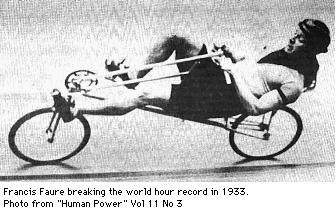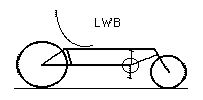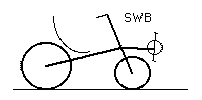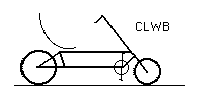FAQ for Recumbent Bikes from HPVA |
|
First released on 12-Jan-95. Updated on 03/05/2012
Q. What IS that thing ?!?A. Well, it's called a 'recumbent' bicycle. The word recumbent refers to the seated position; many enthusiasts have also taken to calling them 'bents'. They usually have two wheels although some have three. They are most often powered by pedaling with your legs, but some bents are hand powered, some are both hand and foot powered. Q. Are they comfortable?A. They are very comfortable. Recumbents seats are larger and you actually sit in the seat. You aren't perched on top of a narrow saddle which can tend to cause numbness and chafing. The handlebars are either above the seat at shoulder level, or below the seat at a position where your arms hang down naturally. This combination creates a comfortable ride making long distance riding free from neck strain, saddle sores, and wrist pain. Q. Are they difficult to ride?A. No. It may take you a little time to get used to the feel and handling of the bike. There are variations in handling just as there are in uprights- some are fast, twitchy racing models and others are smooth, stable touring models. Be forewarned though, recumbents use different muscles, so even if you are a very fit upright rider, you will experience difficulty climbing hills until you develop the new muscle groups. Q. Do they "do" hills?A. Yes, they do "do" hills. Some people think that because you can't stand on the pedals, that you can't ride up hills. Recumbents do tend to be slower going up hills, but as long as you keep pedaling the bike keeps moving. Depending on how steep a hill you're climbing, you may want a low granny gear ( and a good set of lungs), which will enable you to spin your way to the top. Usually you can keep up with some of the upright riders, and if any time was lost climbing, you will make up for it on the downhills and flat ground. Q. Are they faster?A. Well, this is very controversial. In the IHPVA sanctioned events, all the land speed records are held by recumbent or semi-recumbent designs. The real question you are asking is, will you be faster on a recumbent? The answer is, "maybe". There are so many factors involved; how long you've been riding, how long you've trained on the recumbent, style and weight of the bike, topography - hilly, mountainous, flat. Since the biggest factor limiting speed is aerodynamic drag, if you want to go really fast, use a recumbent with a well-designed fairing or a full body. In this case, the answer is YES, they are faster. Q. Are recumbents hard to see?A. Since recumbents are relatively uncommon, they are "noticed"; "visible" is another question. You do sit lower than on a traditional diamond frame bike. Depending on which recumbent you own, you may want to make yourself a little more visible. You can do that by adding a flag to your bike on an extended rod (Burley style), and also by wearing a bright helmet or jacket/vest. To be fair to car drivers, whose attention and concentration are on everything except their driving, I would recommend doing something to get their attention especially if you're riding on heavily used roads. Q. How do you steer it?A. Generally, recumbents have either 'above seat steering' (ASS), or 'under seat steering' (USS). On the above seat steering bents, the handlebars are located at about shoulder height giving them the "chopper" look. On the under seat steering bikes, they are located just beneath the seat. If you are sitting on a chair right now, let your hands hang loosely at your side; this is where your handlebars would be. Above seat steering looks more conventional and is therefore sometimes favored by beginners; but USS bents are really no more difficult to control. Q. Have recumbents been around a while or are they a recent invention?A. Recumbents have been around since the mid 1800's with the Macmillan Velocipede and the Challand Recumbent.
Unfortunately Faure's hour record created a controversy amongst the Union Cycliste Internationale (U.C.I.), the governing body for bicycle races. The controversy was based on whether the Velocar was a bicycle and whether the time records were legal. In February 1934, the U.C.I. decided against Faure's record and banned all recumbents and aerodynamic devices from racing. That is the reason why recumbents have not gained popularity in the racing scene, and why they have not been mass produced by bike manufacturers. For over a century since the introduction of the Rover Safety Cycle, built in England in 1884, the design of the basic diamond frame bicycle has hardly changed. Q. What are the different styles of recumbents?A. The most noticeable difference between the different styles is the length of the bike. There are long wheel base (lwb), short wheel base (swb), and compact long wheel base bikes (clwb).
Q. I'm still slow! How long does it take before I'm up to speed?A. Since it takes time to develop new leg muscles it will depend on how often and the amount of time you spend on your trusty steed. For me, it took about two weeks commuting on it 20 miles a day. For others it may take up to a month or it may take less than two weeks. It all depends on your physical fitness and the how hard you choose to ride. By all means... don't give up !! Q. How much do they cost?A. Recumbents start at around $350 and can go as high as you want to pay. Because of their low production volumes, a recumbent tends to be more expensive than a mass-produced upright bike. So when comparing prices, bear in mind you're buying a custom or very low production bike. Expect to pay $1200 or more for a high quality bike. This price range will give you very good components, a good frame and less weight. Q. Where can I find out more about recumbents?A. Here are some sources: |
 In
1933 Charles Mochet built a supine recumbent named the "Velocar". Between
the years of 1933 and 1938 pro racer Francois Faure, while riding the
Velocar, set several speed records for both the mile and kilometer. In
Paris on July 7, 1933, Francis Faure broke the 20 year-old hour record of
44.247 km. by going 45.055 km.
In
1933 Charles Mochet built a supine recumbent named the "Velocar". Between
the years of 1933 and 1938 pro racer Francois Faure, while riding the
Velocar, set several speed records for both the mile and kilometer. In
Paris on July 7, 1933, Francis Faure broke the 20 year-old hour record of
44.247 km. by going 45.055 km. A long wheelbase bike (LWB) is 65" - 71". Their ride is quite smooth,
comfortable, fast and stable but due to their length, low speed
maneuverability can be a bit tricky on busy streets or on narrow paths.
Examples: Longbike, Linear, Infinity, Tour Easy.
A long wheelbase bike (LWB) is 65" - 71". Their ride is quite smooth,
comfortable, fast and stable but due to their length, low speed
maneuverability can be a bit tricky on busy streets or on narrow paths.
Examples: Longbike, Linear, Infinity, Tour Easy. A short wheelbase bike (SWB) is 33" - 45". Their front wheel is underneath
or a little ahead of the riders knees, with the crankset mounted on a
boom. They have quick handling, are easy to maneuver, and they are more
compact, making it easier to transport and stow than a lwb. Examples:
Lightning P-38, Presto.
A short wheelbase bike (SWB) is 33" - 45". Their front wheel is underneath
or a little ahead of the riders knees, with the crankset mounted on a
boom. They have quick handling, are easy to maneuver, and they are more
compact, making it easier to transport and stow than a lwb. Examples:
Lightning P-38, Presto.